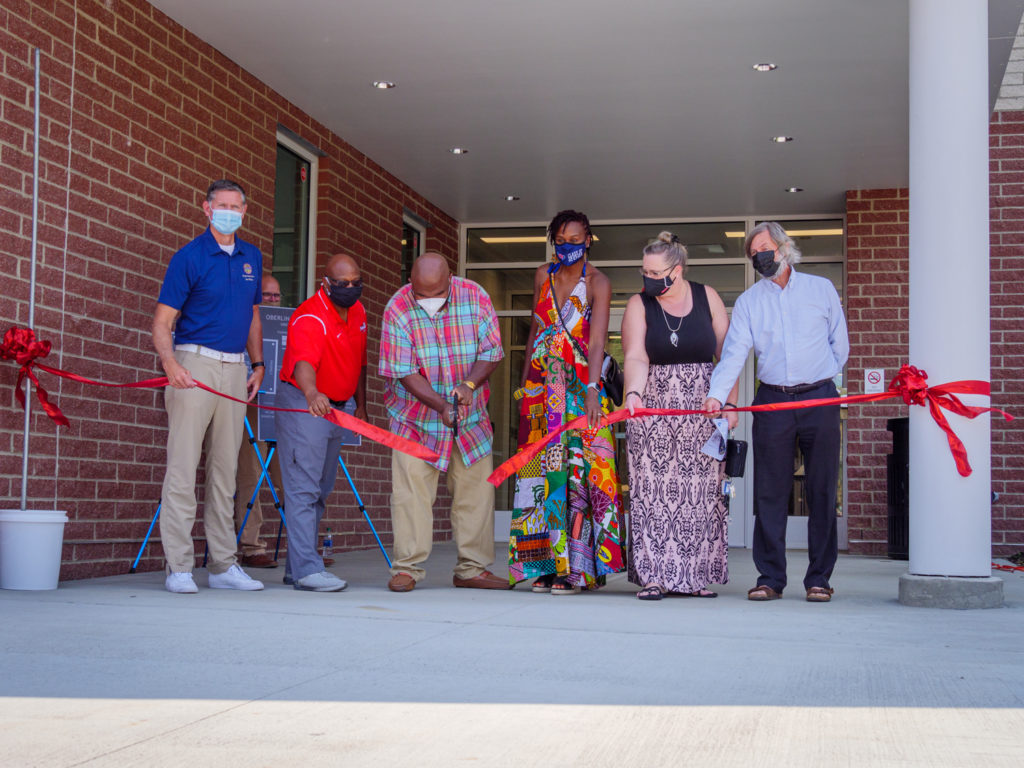Oberlin City Schools Elementary School Ribbon Cutting
The Oberlin City School District, community, dignitaries along with construction and design professionals gathered on September 12th, to celebrate the opening of the new Oberlin elementary school. This 62,000 sf, 21st century learning facility, features collaborative spaces and advanced environmental control systems. Interior spaces can be reconfigured to meet the changing needs of the district and provide educational opportunities for students of all ages.
Speaking at the ceremony, Dr. David Hall commented, “Oberlin City Schools embarked on a journey almost 10 years ago to redesign our pre-K 12 facilities. This journey was led by instrumental community leaders,” referring to previous superintendent John Schroth and former OCS Board President Barry Richards. “A facilities team was formed consisting of community members, staff, parents and administrators to make that vision a reality. It implements 21st century teaching strategies across a new facility and all of these stages were critical points to move the district forward.”
Dr. Hall thanked the community for their support of the longtime project.
Superintendent of Oberlin City Schools, Dr. David Hall, gave an opening address, along with Oberlin City Schools Board President, Jason Miller and Ohio State Representative Joe Miller and architect, Brad Gellert.
Celebrating a New, Sustainable Elementary School
The facility cost $17.8 million dollars and was a collaborative project that brought together Oberlin residents, Oberlin City School Staff, the Ohio Facilities Construction Commission, City Government, Oberlin College, Greenspace Construction, and ThenDesign Architecture. The project responds to the schools IB curriculum and includes a number of forward-thinking design elements.
Project Manager, Brad Gellert commented, “The district and community had a goal in mind of creating a building that met current the needs of Pre-K through 5th grade students and also the future student needs by constructing a building that could be reconfigured due to changing conditions.”
As a result, the building features a STEAM (Science, Technology, Engineering, Arts, Mathematics) Lab, an extended gymnasium space, open and flexible classroom spaces, advanced environmental controls, and an emotional sensory room.
Dr. Hall spoke about the importance of the building’s environmental impact, “Sustainability is important to the district and our community.” Continuing the theme of a collaborative design project, Dr. Hall recalled, “We created a sustainability committee which provided valuable information on our new Pre-K-5 sustainability initiatives.” These initiatives included, a solar installation that provides 80% of the building’s energy needs, electrical power vehicle charging stations and an environmental dashboard that monitors energy use.
This environmental dashboard, which was partially funded by a grant from Oberlin College Green Edge Fund, can be used by future students to better understand how the building’s energy use affects the environment.
Other low-cost sustainability measures included enhanced insulation in the building’s envelope, orienting the building so its longest side faces north, while also adding larger windows to that façade. This minimizes heat gain and the need for greater cooling.
Attendees included community members, dignitaries, school administration and students.
Oberlin's "All Inclusive" Public Education
The ceremony was also attended by Ohio State Representative, Joe Miller. Miller, who also attended the building’s groundbreaking ceremony commented on the historic importance Oberlin placed on public education, “It didn’t matter whether students were black or white, Christian or Jewish, it just didn’t matter.” Miller continued, “The Oberlin community said, “We will educate all (185 years ago),” this was public education at its best, they pioneered it and that’s something to be proud of.”
Miller, a former high school social studies teacher, is a strong advocate of public education, and felt Oberlin’s example of inclusion and diversity was admirable.
“Together we will provide education for all children, their zip code doesn’t matter, their socioeconomic status doesn’t matter, where they’re from originally doesn’t matter. They all have an equal shot. You have provided a facility to meet everyone’s needs. I’m so proud of you for doing that.”
After the Ribbon Cutting Ceremony, Dr. Hall who is passionate about educating Oberlin’s students commented, “I’m blessed, this is the job I want to do, and can’t think of anything else I would rather do. The last year has been an obstacle, it’s been challenging, but we are overcoming that and looking forward to the future.”
The New Oberlin City Schools Elementary School Opened for Tours
Oberlin City Schools conducted a dedication ceremony for the new Oberlin Elementary School on Sept. 12. From left: Ohio State Rep. Joe Miller, Oberlin City Schools Superintendent Dr. David Hall, Oberlin City Schools Board President Jason Miller, and board members Farah Emeka, Anne Schaum, and Oberlin City Schools Vice-President Dr. Ken Stanley.

A Successful, "Forward-Thinking" Project
Brad Gellert, the architect on the project commented on why it was successful, “We built it on a very tight budget and during the COVID-19 pandemic. We were able to introduce many new sustainability features like a solar array that powers 80% of the building, the electric vehicle charging stations and the environmental dashboard. These are all very innovative initiatives for a school.”
Sustainability and collaborative learning are the hallmarks of this new educational facility and display how elementary schools can embody these principles.
“To create positive change in the world, you must work collaboratively with others,” said Brad Gellert adding “spending years assisting the district with this project is personal. We are proud to be part of that collaboration, and know you will enjoy the building for many years to come.”

Ryan Caswell
Communications
Get our newsletter with insights, events and tips.
Recent Posts:
Mentor’s CARES House: Autistic Education Comes Home
Perry High School Unveils a State-of-the-Art Welding Lab
ThenDesign Architecture Celebrated its 35th Anniversary
Capital Improvement Plans Work
